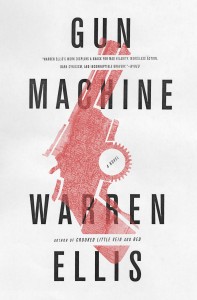
Gun Machine is a tightly wound, little beast of a detective novel. The story begins with two NYC detectives who stumble into an explosive situation. An angry, naked man with a shotgun is set off by an eviction notice and threatens to kill his neighbors in his run-down apartment building. One of the two officers is shot and killed (described in gory detail) and his partner, John Tallow, shoots the man. In the subsequent crime scene clean-up a mysterious apartment is discovered filled with guns arranged in intricate patterns .
The discovery of the apartment opens a massive, spiraling case and John Tallow is assigned it as punishment. The case is of ridiculous scope, political intrigue, and deadly stakes that involves every high profile unsolved murder in Manhattan and this fast paced book drags readers along for the ride. John Tallow is an appropriate protagonist, a loner detective as one would expect of the genre but one clearly of our time. Ellis’ makes a big deal out of describing Tallow as a media junkie: hoarding books and records, always lost in his own thoughts or in parsing information. His obsession even goes as far as having a collection of e-readers and tablets scattered across the back seats of his cop car. Ellis’ addition of these little details is what makes it a joy to read. He even off-handly mentions a café with an instant printer (which is clearly BERG’s Little Printer without mentioning it by name). There is a sense that Warren Ellis and William Gibson are now on converging paths.
Gun Machine also shines in the attention to little details of buildings and descriptions of built environment. Within the genre of detective/police procedural novels, the setting is often as much a protagonist as the human characters and sometimes even more so. Already within the first pages there is a description of a building as
“a grim gray thing, the squat building, a fossil husk for little humans to huddle in. Every other building on this side of the block had had, at the very least, dermabrasion and its teeth fixed. Two stood on either side of the old apartment building like smug Botoxed thirty-somethings bracing an elderly relative.”
This addition of fictional architectural criticism like the above is scattered throughout and much appreciated. Ellis’ writing is violent, irreverent, and highly prescient–usually one step ahead in identifying cultural trends. Watch the book preview below (as animated by Ben Templesmith and read by Wil Wheaton) to get a better idea about Gun Machine.